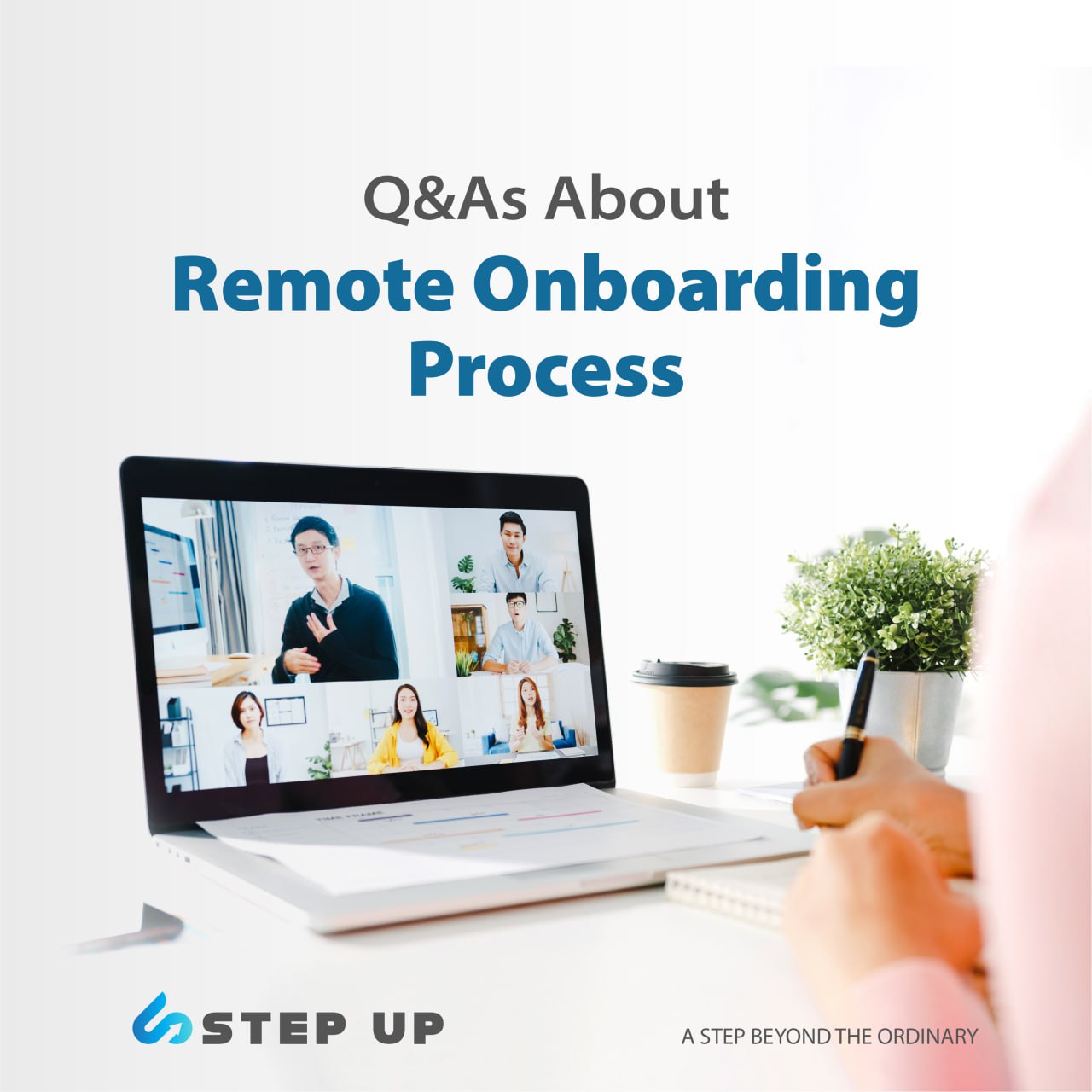-
call: +963 992 185 185
-
Mail: [email protected]
Recent: Syrian Arab Republic, Damascus.
Opening Hours : 09:00 A.M- 06:00 P.M
9 Q&As About Remote Onboarding Process
Updated on : May 26th, 2025
The remote onboarding process is the first move that will help you to create a positive workplace culture, and help your new employees to engage within the working teams.
That is why all HR professionals highlight the importance of the onboarding process whether you are running an on-site onboarding process or a remote one, as a professional way to welcome your new employees, introduce them to the others, and guide their work process for the first few weeks.
Today, we are going to walk you through the remote onboarding process with this Q&A blog to tell you all about the process details, its benefits, challenges, requirements, and remote onboarding best practices to implement.
1. What Is Remote Onboarding Process?
The remote onboarding process is the process of guiding and training your new hybrid and remote workers to know all the details about the company policies, workplace culture, and work details.
This remote onboarding process is basic not only to guide new people around and introduce them to their co-workers but also as a way to boost their productivity and help them to settle down as fast as possible.
So, if you do not care about your workplace culture, productivity, and timeline then you can ignore running a powerful remote onboarding process.

2. Why the Remote Onboarding Process Is Important?
Having a remote job means having many different criteria to consider next to ordinary job requirements.
However, we can say that the onboarding process has the same impacts and benefits for both types; thus, let us introduce you to remote onboarding process benefits, that will make the onboarding process a basic part of your recruiting approach.
· Better Employees Productivity:
Think of this like that, well-trained employees will do much better than someone who does not know what he/she is doing.
As knowing what you are doing will help you to function better; hence, better productivity will be achieved.
· Improved Retention Rate:
Improving your staff retention rate should be a basic goal among your business goals; especially with all its amazing benefits that will empower your business.
Moreover, the remote onboarding process will for sure help you do so with all the training and guidance as your new employees will be more loyal to your business.
· Flexible Work:
As a manager or a CEO, you are for sure always looking for better results and outcomes to empower your work, and in 2023 we can say that flexibility is highly appreciated.
Furthermore, the remote onboarding process will introduce your new workers to all the required details; thus, they will be able to work with the right workflow and achieve their required tasks on time.
· Enhanced Engagement and Communication Level:
Simply when you introduce people to each other, and that is what should be done in the remote onboarding process, then they will know each other, communicate easily, and build positive work relationships.
3. Who Should Run the Remote Onboarding Process?
Basically, the remote onboarding process is part of the HR strategies and your human resources specialist should be a part of it.
However, running this process should be the responsibility of each department manager or leader to guide and teach the new employees about their tasks and introduce them to their new team.
4. Who Should Attend the Remote Onboarding Process?
As we said the remote onboarding process should be managed by the direct manager; however, when talking about attending then we must mention that other team members must exist.
Especially in the first session, the CEO, HR specialist, and supervisors should attend to meet the new people and introduce themselves to them too.
5. Who Is the Remote Onboarding Process For?
The remote onboarding process is for the company’s newly hired people to know how the work is done and what is the general company system.
On the other hand, we can say that the onboarding process can also be done for people who transform from one department to another in the same company.
6. How Long Should the Remote Onboarding Process Last?
The remote onboarding process duration varies depending on several criteria; however, we can say that the remote onboarding process could take between two weeks and three months.
Depending on a new employee’s role, responsibilities, and seniority.
7. What Are the Remote Onboarding Process Challenges?
Even though that remote onboarding is a big and basic process, and helps you to avoid going through hiring the wrong person; however, like any other job-related detail, it comes with some challenges:
· Online Connecting:
Most likely the entire remote onboarding process will be an online one if you applied for a remote job.
That means that all the meetings and training will be through an online connection.
· No of Face-to-Face Interaction:
Even if you have the best remote workplace culture; yet, being a part of remote work will most likely mean no personal interaction with your colleagues.
Which could be a challenge for people just joining a company.
· Lack of Resources:
Many people enjoy working in big companies to benefit from the great available resources for work and break time; however, when talking about the remote onboarding process, then that does not include benefiting from any available physical resources.
This would be a big deal for remote workers who just started their careers, as they may need resources and support to do their tasks efficiently.

8. What Are the Technical Requirements for Remote Onboarding Process?
Whether these remote onboarding tools were on the company owner or on the employees; however, these equipment or requirements must be included to work efficiently and effectively.
Moreover, many people take this into consideration when hunting for job opportunities:
· Internet:
The internet is a basic part of our modern life, how if we are talking about remote working; thus, for sure you will need a fast and stable internet connection to attend the remote onboarding process, and even to work.
· Laptop:
The sure thing is that you will need a laptop to work online; however, the specifications of that laptop will differ depending on your position requirements, and type.
· Camera:
If you are a part of your customer services team, then you will for sure require a camera with good resolution to run meetings and video calls with quality.
· Headset with Mic:
Even if your company runs a one-in-month meeting, you will still need a headset to attend an online meeting, know what is going on, and even participate and engage with your colleagues.
9. What Are the Best Practices and Tips for Effective Remote Onboarding Process?
If you are looking for secret management tips and tricks for managers to run an effective remote onboarding process, then we are glad to share with you these powerful practices for success:
· Prepare a 6 Weeks Working Strategy:
Being prepared is a key factor in anything success, how if we are talking about remote onboarding strategy.
Thus, you must plan a strategy to guarantee success and prevent the best employees from quitting; moreover, prepare your new people to handle their tasks effectively without causing any problems.
· Run Video Meetings:
Even through the camera, the eye connection has the magic of building a stronger relationship among your teams.
Therefore, you must run regular video meetings to break the ice and motivate your team to communicate and engage with each other, and with the company activities.
· Build Positive Culture:
Yes, even with online work culture, you still can build a positive workplace culture where your people can engage and grow their potential.
Moreover, this building effect must start within the remote onboarding process to introduce your new hire to your corporate in the best way.
· Schedule Training Sessions and Time:
If you want to achieve results; then you must run an organized remote onboarding process, where everything is scheduled with days and hours calendars.
This will not only make your process more effective and professional but also give a better public image of your company’s professionalism among your employees.
· Use Central Tools and Technologies:
Sure, as a remote working company, you will be using certain applications and platforms to share data and tasks among your employees.
Thus, your remote onboarding strategy should include training on how to use these platforms in order to know about their tasks and other company-related details.
· Avoid Over Communication:
We know we said you should communicate earlier; however, you should differentiate between good communication to build positive work relations and sharing good information.
And over communication where your employees will have to focus on your call or message rather than focusing on doing their tasks and studying the company’s policy.
· Start with Easy and Clear Tasks:
During the remote onboarding process, you will share and assign tasks to your new hires, and expect actual results from them not just expecting them to sit around and watch.
However, make sure to start with a clear and easy task to motivate them, and avoid complicated tasks that will require time, and a startup mistake could happen during them.
Finally,
Running a remote onboarding process will come back to your company with a lot of great results that will boost your productivity and revenue.
Thus, make sure to start it with every new hire, and remember we are here and ready to help you build your winning team.


